Is Kiwi a Tropical Fruit? Explore!
The kiwi fruit, while often associated with New Zealand, is not classified as a tropical fruit.
It is originally from eastern China and favors temperate climates for growth, which distinguishes it from tropical fruits that require warm, humid conditions.
Kiwi fruit, also known as Chinese gooseberry initially, has a history of cultivation that moved from China to New Zealand.
Unlike tropical fruits such as bananas, coconuts, and papayas, kiwis grow in a temperate zone, which is characterized by mild temperatures and sufficient rainfall, but not the year-round heat and humidity of the tropics.
Despite its exotic image, the kiwi is a temperate fruit, thriving in conditions that differ from tropical environments.
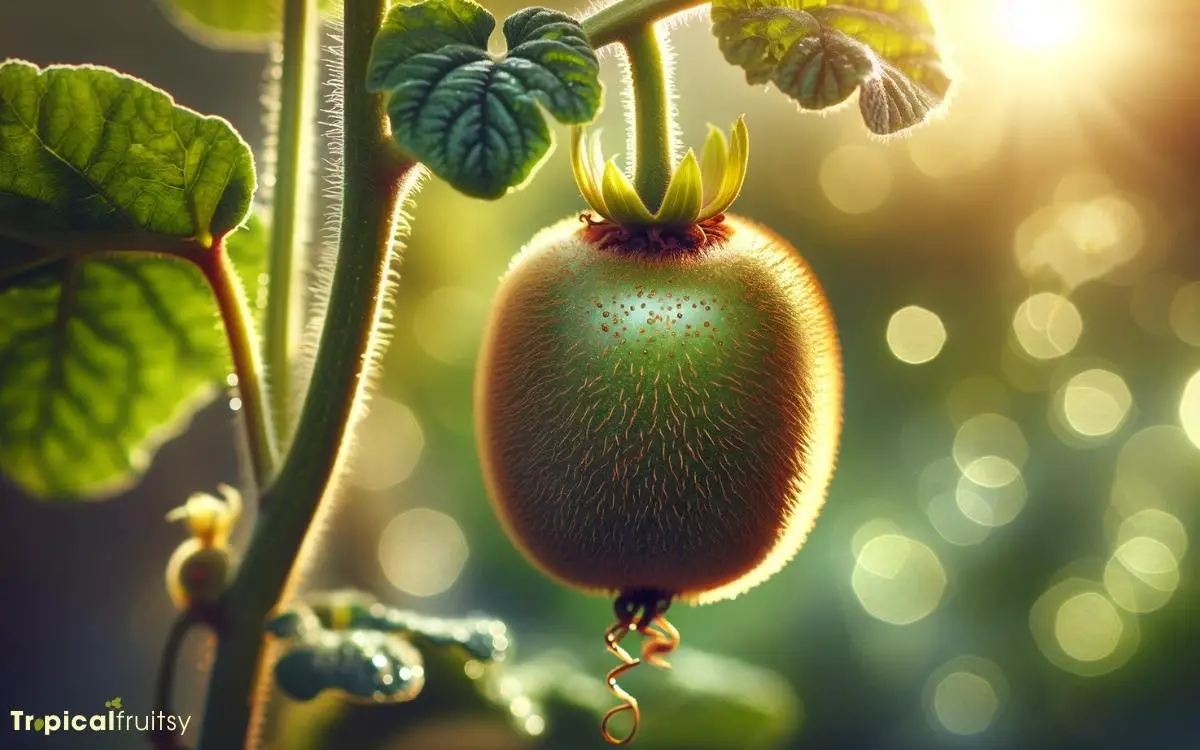
Key Takeaway
4 Attribute: Kiwi Fruit and Tropical Fruits
| Attribute | Kiwi Fruit | Tropical Fruits |
|---|---|---|
| Origin | Eastern China | Various tropical regions |
| Preferred Climate | Temperate | Tropical (warm, humid) |
| Examples | Kiwi | Mango, Pineapple, Banana |
| Main Cultivation Regions | New Zealand, Italy, Chile | India, Brazil, Thailand |
Understanding Fruit Classifications

Classifying fruits involves categorizing them based on specific criteria. These criteria can include the climate of origin, plant family, and physical characteristics of the fruit.
This systematic approach allows botanists and food scientists to analyze and understand the myriad fruit varieties within the context of their evolutionary adaptation and culinary uses.
For example, tropical fruits are typically grown in warm climates and are characterized by their ability to thrive in conditions with high humidity and temperatures. These fruits often exhibit vibrant colors, juicy textures, and distinct flavors.
On the other hand, fruits from temperate regions adapt to cooler environments and may have mechanisms for winter dormancy.
The family and genus of a fruit also contribute to its classification, providing insight into its relatedness to other species and potential nutritional profiles.
Kiwi: Origin and History

The kiwifruit, originally known as the Chinese gooseberry, traces its origins to the Yangtze River valley of China.
Cultivated by the Chinese for centuries, the fruit was primarily consumed within its native habitat and remained relatively unknown to the rest of the world. The first recorded description dates back to the 12th century during the Song dynasty.
By the early 20th century, seeds were exported from China to New Zealand, where the fruit was renamed ‘kiwifruit’ after the kiwi bird, a national symbol of New Zealand. This renaming was part of a marketing strategy to avoid the high tariffs on berries.
The fruit’s commercial potential was realized when New Zealand growers developed the first commercially viable cultivar, leading to widespread cultivation and global distribution.
The Climatic Needs of Kiwi
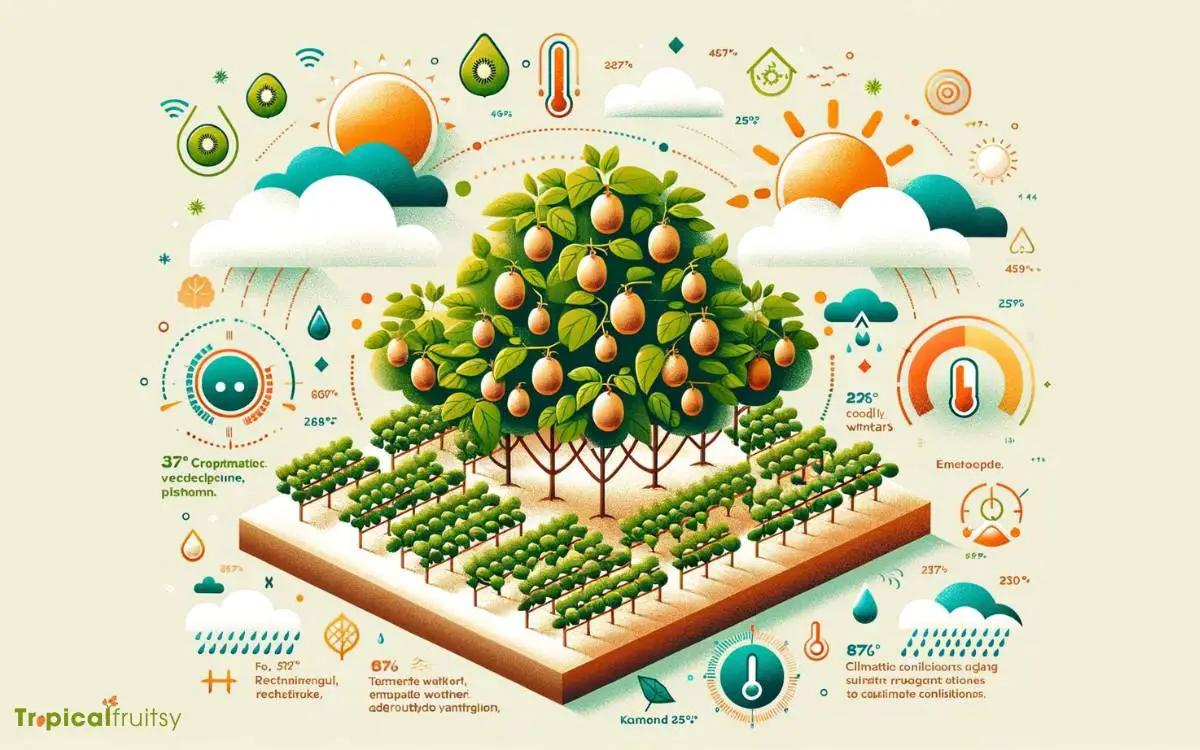
The successful cultivation of kiwifruit hinges on meeting specific temperature requirements, which are pivotal for the plant’s growth phases, including dormancy, flowering, and fruit set.
Optimal temperature ranges vary for different kiwi varieties, with some tolerating cooler climates and others requiring warmer conditions.
Precipitation levels must also be carefully managed, as kiwifruit is sensitive to both water stress and excessive moisture, which can lead to root rot or other diseases.
Temperature Requirements
Kiwi plants thrive in temperate climates with distinct seasons, requiring winter chill to break dormancy and moderate summer temperatures to foster fruit development.
These conditions are critical for successful cultivation:
Winter Chill Requirements:
- Minimum of 700 to 1000 chilling hours below 7°C.
- Essential for proper vine rest and subsequent flowering.
Optimal Summer Temperatures:
- Daytime temperatures between 20°C to 25°C.
- Nighttime temperatures slightly lower to avoid heat stress.
Temperature Variations:
- Diurnal temperature swings aid in sugar accumulation.
- Seasonal shifts influence fruit size and quality.
This meticulous balance of temperature is pivotal for kiwi fruit set and maturation.
Transitioning from temperature to water needs, the role of precipitation levels is the next critical factor in kiwi cultivation.
Precipitation Levels
Adequate rainfall or irrigation, typically ranging from 25 to 40 inches annually, is crucial to sustain kiwi vine growth and fruit production.
Kiwi plants thrive in conditions where moisture is abundant and evenly distributed throughout the growing season.
The precise amount of water required can vary based on soil type, vine age, and local climate conditions, but the goal is to avoid water stress, which can adversely affect yield and fruit quality.
| Climatic Factor | Requirement for Kiwi |
|---|---|
| Annual Rainfall | 25-40 inches |
| Distribution Pattern | Even throughout the year |
| Irrigation | Supplemental as needed |
| Water Stress | To be avoided |
Scientific analysis of kiwi’s water dependency demonstrates a significant divergence from typical tropical fruits, which often hail from regions with higher humidity. This comparison will be elucidated in the following section.
Comparing Kiwi to Tropical Fruits
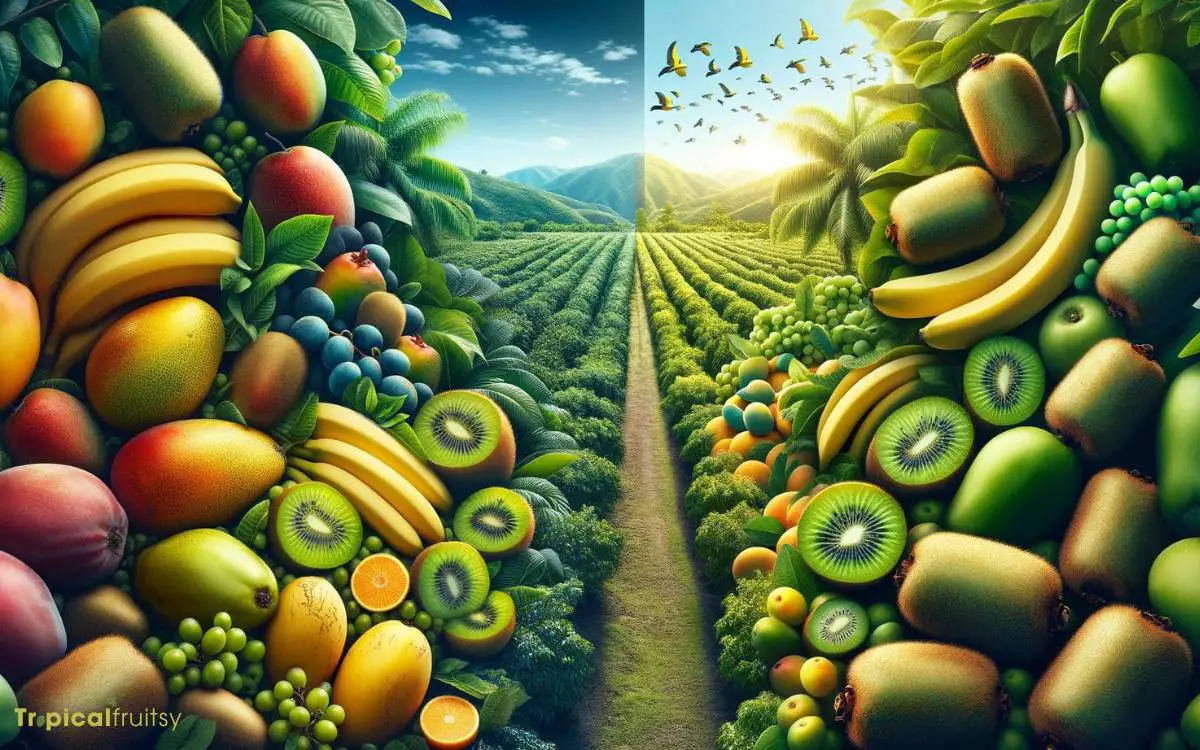
Despite its exotic appeal, kiwi fruit originates from a temperate climate, setting it apart from typical tropical fruits like mangoes, pineapples, and papayas that thrive in warmer regions.
To analyze the distinctions:
Climate Adaptability:
- Kiwi: Thrives in temperate zones with distinct seasons.
- Tropical Fruits: Require consistent, year-round warmth.
Growth Requirements:
- Kiwi: Prefers a winter chill for successful bud break.
- Tropical Fruits: Sensitive to frost, need high humidity.
Harvesting and Cultivation:
- Kiwi: Often harvested in late autumn.
- Tropical Fruits: Typically have multiple harvests due to constant growing conditions.
This comparative analysis reveals that despite kiwi’s tropical mystique, its cultivation and climatic needs align more closely with temperate fruits, distinguishing it from the true tropical varieties that flourish under conditions of persistent heat and humidity.
Misconceptions About Kiwi

Common misconceptions regarding the kiwi fruit often stem from its exotic appearance and the widespread association of its name with New Zealand, a country known for its kiwi cultivation.
However, the kiwi plant’s origins lie in the temperate climate zones of China, not the tropical regions as is frequently presumed.
This confusion has led to a misunderstanding of the kiwi’s agronomical needs, particularly its capacity to withstand lower temperatures, which is uncharacteristic of tropical fruits.
Kiwi’s Origin Confusion
Although often perceived as a tropical fruit due to its exotic taste and appearance, the kiwi actually originates from temperate regions of China.
This misconception is likely due to a combination of factors:
Climatic Assumptions:
- The humid and subtropical conditions of some kiwi-growing regions.
- The common association of vibrant fruits with tropical climates.
Commercial Branding:
- Marketing strategies that emphasize the fruit’s exotic qualities.
- The use of the term “kiwi” itself, which resonates with New Zealand’s diverse ecology, including tropical elements.
Agricultural Dissemination:
- The global cultivation in varied climates that resemble the fruit’s native habitat.
- Adaptation of the kiwi plant to different latitudes, leading to a wider range of growth environments.
This analysis provides an understanding of how the kiwi’s true origins are often overshadowed by these prevailing misconceptions.
Cold-tolerant Kiwi Reality
Several species of kiwi plants exhibit a surprising level of cold tolerance, challenging the widespread belief that they are exclusively suited to tropical conditions.
Contrary to popular misconceptions, kiwifruit, particularly the variety Actinidia arguta, often referred to as the hardy kiwi, can withstand temperatures as low as -25 degrees Celsius.
This resilience is attributed to the plant’s dormant phase during winter, where metabolic activities are minimized, and cellular structures are fortified against freeze-induced damage.
Scientific analysis of the kiwi’s cold endurance emphasizes the species’ adaptability and refutes the simplistic categorization of kiwis as tropical fruits.
These findings necessitate a reassessment of agricultural practices and zone classifications for kiwi cultivation, allowing for expansion into non-tropical regions previously deemed unsuitable.
How Kiwis Are Grown Globally
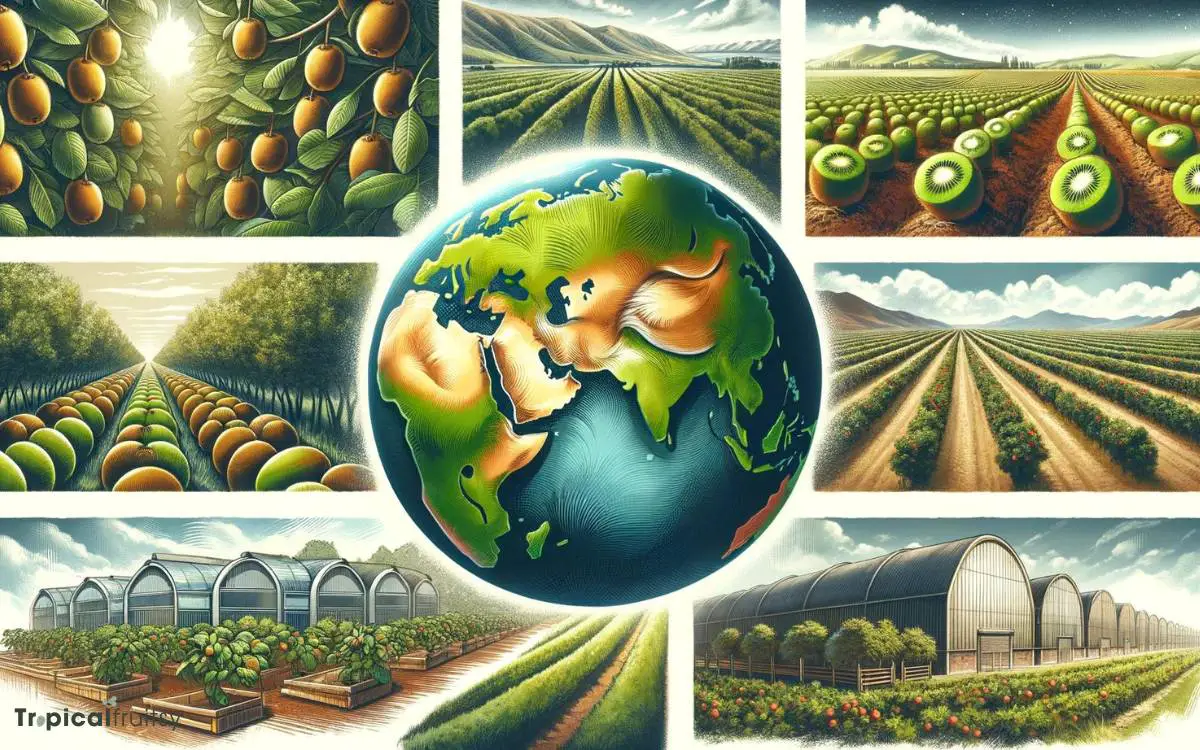
Kiwifruit cultivation spans various continents, with major producers including New Zealand, Italy, and Chile, each employing specific horticultural techniques to optimize growth in their respective climates.
The agronomic practices are tailored to local environmental conditions and market demands, reflecting a sophisticated understanding of kiwifruit biology and global agricultural trends.
New Zealand:
- Pioneered the ‘Hayward’ variety, known for its extended storage life and suitability for export.
- Innovations in vine training and canopy management enhance sunlight exposure and fruit quality.
Italy:
- Adopts high-density planting systems for increased yield per hectare.
- Utilizes advanced irrigation strategies to mitigate the effects of a variable Mediterranean climate.
Chile:
- Takes advantage of the Southern Hemisphere’s counter-seasonal production to supply markets during off-peak periods.
- Implements integrated pest management practices to reduce chemical use and meet international standards.
Determining the Kiwi’s Category
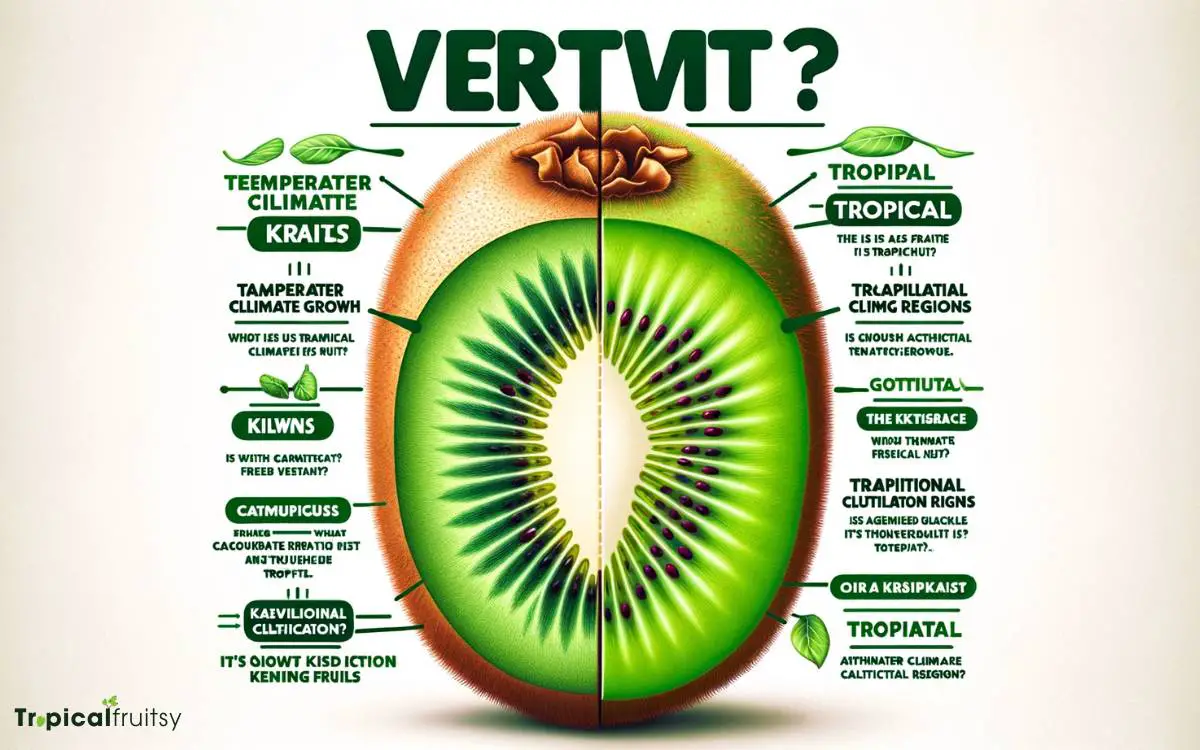
Classifying kiwi in the correct fruit category requires understanding its climatic needs and growth patterns.
Kiwifruit, or Actinidia deliciosa, thrives in temperate climates with distinct winter and summer seasons.
Unlike tropical fruits, which develop in consistently warm environments, kiwis require a chilling period to break bud dormancy, a trait more characteristic of fruits from temperate zones.
The plant’s success in regions with cool winters and warm summers further delineates its categorization.
Moreover, the kiwi’s growth cycle, including a period of dormancy followed by a robust growing season, aligns with temperate fruit cultivation practices.
Therefore, from a botanical perspective, kiwifruit is more accurately described as a temperate fruit rather than a tropical one.
Conclusion
The kiwi fruit, while often erroneously hailed as a tropical marvel, botanically anchors itself in a subtler, temperate realm.
This verdant emerald of the fruit world necessitates a unique climate, distinct from the sweltering embrace of the tropics.
Global cultivation patterns underscore its versatility, yet firmly delineate its categorization amidst temperate botanical brethren.
Thus, the kiwi stands as a testament to the complexity and nuance of fruit classification, challenging lay perceptions with scientific rigor.






